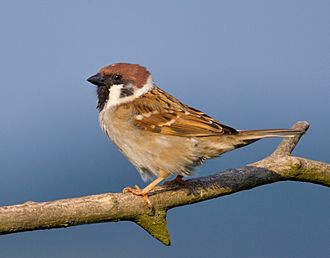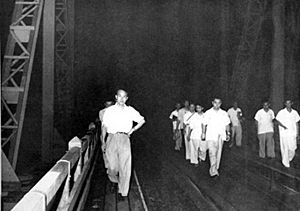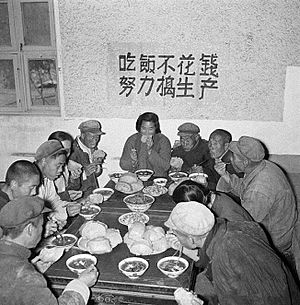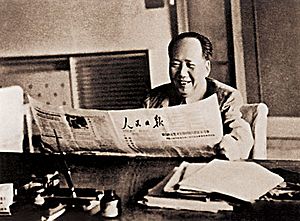Great Chinese Famine facts for kids
Quick facts for kids Great Chinese Famine三年大饥荒 |
|
|---|---|
| Country | People's Republic of China |
| Location | Half of the country. Death rate were highest in Anhui (18% dead), Chongqing (15%), Sichuan (13%), Guizhou (11%) and Hunan (8%). |
| Period | 1959–1961 |
| Total deaths | 15–55 million |
| Observations | Considered China's most devastating catastrophe. |
| Theory | Result of the Great Leap Forward, people's commune, Four Pests campaign and other factors. |
| Consequences | Termination of the Great Leap Forward campaign |
The Great Chinese Famine (Chinese: 三年大饥荒; literally "three years of great famine") was a famine that ocurred between 1959 and 1961 in the People's Republic of China (PRC). Some scholars have also included the years 1958 or 1962. It is widely regarded as the deadliest famine and one of the greatest man-made disasters in human history, with an estimated death toll due to starvation that ranges in the tens of millions (15 to 55 million). The most stricken provinces were Anhui (18% dead), Chongqing (15%), Sichuan (13%), Guizhou (11%) and Hunan (8%).
The major contributing factors in the famine were the policies of the Great Leap Forward (1958 to 1962) and people's communes, launched by Chairman of the Chinese Communist Party Mao Zedong, such as inefficient distribution of food within the nation's planned economy; requiring the use of poor agricultural techniques; the Four Pests campaign that reduced sparrow populations (which disrupted the ecosystem); over-reporting of grain production; and ordering millions of farmers to switch to iron and steel production. During the Seven Thousand Cadres Conference in early 1962, Liu Shaoqi, then President of China, formally attributed 30% of the famine to natural disasters and 70% to man-made errors ("三分天灾, 七分人祸").
Contents
Causes of the famine
The Great Chinese Famine was caused by a combination of radical agricultural policies, social pressure, economic mismanagement, and natural disasters such as droughts and floods in farming regions.
Great Leap Forward
During the Great Leap Forward, farming was organized into people's communes and the cultivation of individual plots was forbidden. Previously farmers cultivated plots of land given to them by the government. The Great Leap Forward led to the agricultural economy being increasingly centrally planned. Regional Party leaders were given production quotas for the communes under their control. Their output was then appropriated by the state and distributed at its discretion. In 2008, former deputy editor of Yanhuang Chunqiu and author Yang Jisheng would summarize his perspective of the effect of the production targets as an inability for supply to be redirected to where it was most demanded:
In Xinyang, people starved at the doors of the grain warehouses. As they died, they shouted, "Communist Party, Chairman Mao, save us". If the granaries of Henan and Hebei had been opened, no one need have died. As people were dying in large numbers around them, officials did not think to save them. Their only concern was how to fulfill the delivery of grain.
Agricultural techniques
Along with collectivization, the central government decreed several changes in agricultural techniques that would be based on the ideas of later-discredited Russian agronomist Trofim Lysenko. One of these ideas was close planting, whereby the density of seedlings was at first tripled and then doubled again. The theory was that plants of the same species would not compete with each other. In natural cycles they did fully compete, which actually stunted growth and resulted in lower yields.
Another policy known as "deep plowing" was based on the ideas of Lysenko's colleague Terentiy Maltsev, who encouraged peasants across China to eschew normal plowing depths of 15–20 centimeters and instead plow deeply into the soil (1 to 2 Chinese feet or 33 to 66 cm). The deep plowing theory stated that the most fertile soil was deep in the earth, and plowing unusually deeply would allow extra-strong root growth. While deep plowing can increase yields in some contexts, the policy is generally considered to have hindered yields in China.
Four Pests campaign

In the Four Pests campaign, citizens were called upon to destroy mosquitoes, rats, flies, and sparrows. The mass eradication of the sparrows resulted in an increase of the population of crop-eating insects, which had no predators without the sparrows.
Illusion of superabundance
Beginning in 1957, the Chinese Communist Party began to report excessive production of grain because of pressure from superiors. However, the actual production of grain throughout China was decreasing from 1957 to 1961.
This resulted in an "illusion of superabundance" (浮夸风), and the Party believed that they had an excess of grain. On the contrary, the crop yields were lower than average. For instance, Beijing believed that "in 1960 state granaries would have 50 billion jin of grain", when they actually contained 12.7 billion jin. The effects of the illusion of superabundance were significant, leaving some historians to argue that it was the major cause of much of the starvation throughout China. Yang Dali argued that there were three main consequences from the illusion of superabundance:
First, it led to planners to shift lands from grain to economic crops, such as cotton, sugarcane, and beets, and divert huge numbers of agricultural laborers into industrial sectors, fueling state demand for procured grain from the countryside. Second, it prompted the Chinese leadership, especially Zhou Enlai, to speed up grain exports to secure more foreign currency to purchase capital goods needed for industrialization. Finally, the illusion of superabundance made the adoption of the commune mess halls seem rational at the time. All these changes, of course, contributed to the rapid exhaustion of grain supplies.
Natural disasters

In 1958, there was a notable regional flood of the Yellow River which affected part of Henan Province and Shandong Province. It was reported as the most severe flood of the Yellow River since 1933. In July 1958, the Yellow River flood affected 741,000 people in 1708 villages and inundated over 3.04 million mu (over half a million acres) of cultivated fields. The largest torrent of the flood was smoothly directed into the Bohai Sea on 27 July, and the government declared a "victory over the flood" after sending a rescue team of over 2 million people. The spokesperson of the Flood Prevention Center of Chinese government stated on 27 July 1958, that:
This year we defeated the large flood without division of torrents or breaks on dams, which secures the big harvest of the crops. This is yet another miracle created by the Chinese people.
But the government was encouraged to report success and hide failures. Because the 2 million farm laborers from the two provinces were ordered away from the fields to serve as a rescue team and were repairing the banks of the river instead of tending to their fields, "crops are neglected and much of the harvest is left to rot in the fields". On the other hand, historian Frank Dikötter has argued that most floods during the famine were not due to unusual weather, but to massive, poorly planned and poorly executed irrigation works which were part of the Great Leap Forward. At this time, encouraged by Mao Zedong, people in China were building a large number of dams and thousands of kilometers of new irrigation canals in an attempt to move water from wet areas to areas that were experiencing drought. Some of the works, such as the Red Flag Canal, made positive contributions to irrigation, but researchers have pointed out that the massive hydraulic construction project led to many deaths due to starvation, epidemics, and drowning, which contributed to the famine.
Aftermath
Initial reactions and cover-ups
Local party leaders, for their part, conspired to cover up shortfalls and reassign blame in order to protect their own lives and positions. Mao was kept unaware of some of the starvation of villagers in the rural areas who were suffering, as the birth rate began to plummet and deaths increased in 1958 and 1959. In 1960, as gestures of solidarity, Mao ate no meat for seven months and Zhou Enlai cut his monthly grain consumption.
In visits to Henan province in 1958, Mao observed what local officials claimed was increases in crop yield of one thousand to three thousand percent achieved, supposedly, in massive 24-hour pushes organized by the officials which they called "sputnik launches". But the numbers were faked, and so were the fields that Mao observed, which had been carefully prepared in advance of Mao's visit by local officials, who removed shoots of grain from various fields and carefully transplanted them into a field prepared especially for Mao, which appeared to be a bumper crop.
The local officials became trapped by these sham demonstrations to Mao, and exhorted the peasants to reach unattainable goals, by "deep ploughing and close planting", among other techniques. This ended up making things much worse; the crop failed completely, leaving barren fields. No one was in a position to challenge Mao's ideas as incorrect, so peasants went to extreme lengths to keep up the charade; some grew seedlings in their bedding and coats and, after the seedlings quickly sprouted, "planted" them in fields—the bedding made the plants look high and healthy.
Like in the massive Soviet-created famine in Ukraine (the Holodomor), doctors were prohibited from listing "starvation" as a cause of death on death certificates.
Cultural Revolution
In January and February 1962, the "7000 Cadres Conference" took place in Beijing, which was attended by more than 7,000 CCP officials nationwide. During the conference, Liu formally announced his conclusion on the causes of the great famine, while the Great Leap Forward was declared "over" by the Chinese Communist Party. The policies of Mao Zedong were criticized.
The failure of the Great Leap Forward as well as the famine forced Mao Zedong to withdraw from active decision-making within the CCP and the central government, and turn various future responsibilities over to Liu Shaoqi and Deng Xiaoping. A series of economic reforms were carried out by Liu and Deng and others, including policies such as sanzi yibao (三自一包) which allowed free market and household responsibility for agricultural production.
However, the disagreement between Mao Zedong, Liu Shaoqi and Deng Xiaoping over economic and social policy grew larger. In 1963, Mao launched the Socialist Education Movement and in 1966, he launched the Cultural Revolution, during which Liu was accused of being a traitor and enemy agent for attributing only 30% to natural calamities. Liu was denied medicine for diabetes and pneumonia; he died in 1969. On the other hand, Deng was accused of being a "capitalist roader" during the Cultural Revolution and was purged twice.
Images for kids
-
Liu Shaoqi visiting North Korea (1963).
See also
 In Spanish: Gran hambruna china para niños
In Spanish: Gran hambruna china para niños






